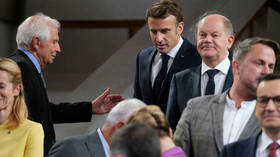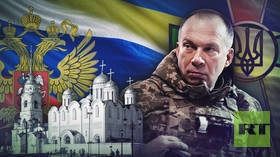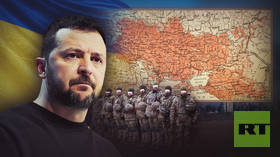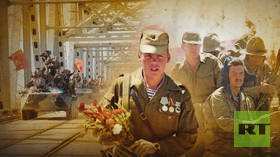Sergey Poletaev: As the second anniversary of the Russia–Ukraine conflict approaches, who has the upper hand?
Ukraine is borrowing from the future just to hang on for dear life. 2024 will be pivotal in deciding the outcome
The forthcoming second anniversary of Russia’s military operation in Ukraine is a symbolic date, but hardly a cause for celebration. In fact, events have to be studied from a considerable remove in order to see the big picture.
Positional deadlock
Any discussion of a breakthrough on the front and military defeat of the Ukrainian Armed Forces (AFU) has long been met with the counter-argument: Let us take Avdeevka (a key Donbass stronghold) first, and then we will talk. On Saturday, that goal was officially achieved.
So what now? In order to crush the enemy and impose our will, we need an effective strategy, a plan forsuccessful combat operations.
By last year, such a system was well established on the defensive side – in the absence of a multiplier advantage, neither side is yet able to break through the front with its own means and conduct successful offensive operations.
Back in the autumn, Avdeevka was described as a kind of test for the Russian Army. The Avdeevka operation began with an attempt to cut off the city and create a ring of encirclement 10km in diameter.
On October 10, after massive artillery preparations, mechanized attacks were launched in two directions – across the railway north of the Avdeevka chemical plant and from the south, from the village of Vodyanoye. Like the enemy’s attacks on Rabotino in the summer, these efforts faltered, and our command – relying on artillery, attack drones, and small assault groups – shifted the center of gravity right into the city itself.
And now, after a fifth month of fighting, the Avdeevka epic has concluded. By maintaining pressure along the entire perimeter and forcing the enemy to stretch its reserves, the Russian Army wore down the city’s garrison over several months of fighting. The situation was exacerbated by supply problems. The only paved road, though still passable and sometimes safe (in December, Ukrainian President Vladimir Zelensky even traveled into the besieged city on it), still did not allow for the necessary supplies and rotations, and more importantly, maintaining control of the route itself required a great deal of effort on the part of the AFU.
From November, the defenses of Avdeevka began to crack, first in the industrial area, then in ‘Tsarskaya Okhota’ – powerful strongholds facing Donetsk known since 2014. Attempts to repel these positions diverted the garrison’s forces from other directions, further weakening the defenses.
In the early days of February 2024, it all came to a head. In a matter of days, Russia cut the northern part of the city in two, crossed the railway, and took the only supply line – Industrial Avenue – under tight fire control.
On Saturday, the battle for Avdeevka came to an end. It marked the most significant shift on the front since the liberation of Artemovsk (Bakhmut) last May.
Let us now talk about how the conflict as a whole can be won.
Months of fighting for the center of Avdeevka, infiltrating the city on foot, attacking through empty heating pipes, and supplying through waterways under the railway – this is true heroism on the part of the fighters and commanders, but it is not a strategy that moves the front and decides the outcome of the conflict.
The Russian Army’s advantages in the air and in armored vehicles have not yet been translated into success; even weak Ukrainian air defenses keep our air force on our side of the front, while armored vehicles, which are forced to gather in columns in minefields, are easy targets for drones and precision fire, even if they are few in number. Yes, things are worse for the enemy, and there are fewer chances of a breakthrough, but the fact remains that since the autumn of 2022, when the current front was formed, we have not seen a single successful attack of operational significance, and the frontal shifts in units of kilometers have been achieved as a result of months of exhausting battles fought virtually on foot.
The exhaustion of the front
On the other hand, this does not mean that our command has no strategy for victory. In the absence of effective means to break through the defenses, it is not the movement of the front or the capture of certain lines that is important – it is the damage inflicted on the enemy, and it is important that the enemy becomes weaker faster than you do.
Avdeevka has become the embodiment of this strategy, which is now being adopted across the entire front. Since the autumn, the Russian armed forces have begun to advance in a number of places, and the same approach as in Avdeevka is being used along the front – stretching and overstretching the enemy’s reserves, and while the enemy is plugging a hole in one area, achieving success in another.
From month to month, this happens more often, and the breakthroughs are deeper and larger. In December – Maryinka, in January – north-east of Soledar (the village of Veseloe) and towards Kupyansko-Svatovsky (the village of Krahmalnoye), in February – the eastern part, the settlement of Belogorovka – and all this amid the slow but regular advance in Avdeevka, as well as the flanks of Artyomovsk towards Chasov Yar, from where we previously had to partially withdraw after taking the town.
Belogorovka is a good example of what is happening on the ground. According to a Ukrainian source, prolonged shelling meant that the Ukrainian positions in the industrial zone had from a third to a half of the fighters left in formation, and the 24-hour drone control of communications made it difficult to rotate and replenish ammunition. In the end, a Russian assault group walked straight into the AFU’s position, and only one Ukrainian soldier survived the battle. He tried to call in artillery fire, but there was no fire support as there were no shells. As a result, in Belogorovka, with a significant ratio of casualties in favor of the attackers, the advance for the day was up to 1.5km along a 3km front – this is a lot by the standards of positional fighting.
In general, Ukrainian and Western sources have been saying with one voice for several months now that the situation is grave and the defenses are becoming increasingly difficult to maintain. The shortage of grenades is getting worse (Russian fire superiority ranges from 3 to 10 times, according to various reports), there is a shortage of men (in many units, this reaches 65-70%), and the AFU’s advantage in small FPV drones has long since disappeared. Some successes, notably the defeat of a Russian assault column near Mariinsky in January, are of little consolation.
The training and motivation of AFU personnel is declining. Deserters, or ‘SZCH-schniki’ (short for the Ukrainian term for ‘unauthorized abandonment of a unit’), have become a real scourge. Rather than abandoning their positions, they simply refuse to fight, preferring instead to be tried. According to the Ukrainian military, one or two such refuseniks can decimate an entire unit in a matter of days or even hours due to the general low morale.
Rear exhaustion
The situation in the rear has been no better. There is the conflict between Zelensky and his former top general, Valery Zaluzhny, which escalated after the failure of the summer counteroffensive and was finally resolved in early February with the resignation of Zaluzhny, followed by the departure of the entire AFU leadership. Some are even comparing it to the purges in the Red Army in 1937-1938, and with good reason – the generals are being replaced not because of ability, but because they are Zaluzhny’s men.
Perhaps Zaluzhny’s outstanding command qualities are a myth, but the troops still love him and consider him a father figure. He is also extremely popular in Ukrainian society. This has not been affected by last year’s failures, nor by the history of mobilization described below. Zaluzhny’s resignation has had a dark effect on the mood in the army, and his successor, the Russian-born Aleksandr Syrsky, nicknamed ‘General 200’ (a reference to the supposed weight of a military coffin and body) for his brutal leadership style, is in danger of being hit by all the negativity to come.
Now on to mobilization. According to the lowest estimates, the irreparable losses of the AFU have exceeded 350,000 people, including the dead, the seriously wounded, and the missing. These are the best fighters – army personnel, veterans, and motivated volunteers. Even if we assume that the losses of the AFU and the Russian Armed Forces are equal (which is not the case due to our superiority in firepower), with such losses, the difference in mobilization potential, which is five times higher in Russia, is already in full swing.
The result: In Russia, the flow of conscripts to military recruitment offices continues unabated, with waiting periods for medical examinations lasting several months in some places, while in Ukraine, volunteers dried up last summer. According to official Ukrainian figures, for every five men lost at the front, there is only one new recruit, and many men of conscription age are hiding abroad.
To make up for losses after the counteroffensive, the Ukrainian military commissars have resorted to the shameful practice of abduction, and scenes of uniformed men abducting men in the streets, raiding gyms, metro stations, and restaurants, which were at first shocking, became part of the bleak Ukrainian landscape.
The maximum number of people mobilized in Ukraine in 2023 is said to have been 100,000 (against the planned 200,000), a small number compared to the half-million target announced for the year. In the autumn, Ukraine began to reform the system of mobilization for this purpose, but implementation has been threatened. It’s not just the shock to society (Ukrainian citizens suddenly realize that everyone is going to war), it’s the lack of funds for recruitment. According to Zelensky, 500 billion hryvnias ($13.5 billion) is needed. This includes allowances, equipment, and supplies. These figures are not available in the Ukrainian budget, and here we come to the next problem – financial exhaustion.
In the first two years, Ukraine’s budget deficit was covered by external injections, maintaining a semblance of financial stability in the face of an almost complete collapse of the civilian economy. However, the announced deficit of $42 billion for 2024 will be very difficult to cover – of the €50 billion allocated for four years, almost €18 billion (more than a third) is to be spent this year, relatively little money is coming from the IMF and other sources, and even if the US Congress finally approves the $61 billion in funding requested by the White House, the Ukrainian budget will still struggle. The only way out is to turn on the printing presses and try to make ends meet at the expense of a falling exchange rate.
Political stability is another problem. With near-monopoly control of the media, Zelensky has a nominal rating of over 60%, but the days of his absolute political monopoly are over. In the autumn, Ukrainian politics was revived and the taboo on criticizing the president was lifted. In May, Zelensky’s term in office will expire – making him formally illegitimate. If the situation on the front and in the rear continues to deteriorate at the current rate, it could lead to a full-blown political crisis. It remains to be seen whether Zaluzhny and former President Pyotr Poroshenko, who has taken him under his wing, will seize the moment.
The next issue is military supplies. The current media hysteria should not be overestimated. While Democrats and Republicans on Capitol Hill square off, NATO warplanes continue to arrive regularly at Rzeszow, Poland, which serves as a rear base. The volume of military supplies to Ukraine is limited not so much by a lack of money as by the depletion of Western arsenals and by political choices. The hypothetical lack of money from Congress will have an impact in a few months at the earliest.
Borrowing from the future
So how will this year go for Ukraine?
First, the new law on mobilization will not increase the number of people willing to fight for Ukraine; on the contrary, the authorities will have more problems on the home front. As a result, the numerical advantage of the Russian Army will at least remain, if not increase. Everything has already been said above about the quality of Kiev’s forcibly recruited personnel.
Second, for objective reasons, the AFU will continue to have problems with artillery. The West will not reach our level of grenade production until 2025 at the earliest, if not later, and the ammunition will first be used to replenish their own empty arsenals. The same goes for armored vehicles. Soviet stocks are running out and the production of new armored vehicles in the West is lagging behind Russia.
Third, Ukraine will increasingly use FPV drones. Their designation as a separate branch of the armed forces seems a controversial decision, but it speaks volumes about priorities. Will the AFU be able to regain at least parity with us in this area? Not a chance – Russia is not standing still either. Long-range Ukrainian air and sea drones are indeed being developed – and while they inflict unpleasant blows on us in the rear, they have no effect on the front.
Fourth, the West will continue to supply Ukraine with missiles. They have proven to be relatively effective, so there will be more NATO missiles, a wider range of them, leading to more strikes and targets. There will also be more air defense assets, possibly including F-16s.
The West, as Ukraine’s sponsor, has decided on a strategy for the coming year – stay on the defensive and try to wear down the Russian forces.
Ukraine will become weaker, but it will fight back in ever more inventive and aggressive ways, hoping that this will force the Kremlin to accept a ceasefire and freeze the conflict. Unable to attack from the front, the enemy will look for ways to hit the rear as hard as possible, to shoot down our planes, and perhaps strike the Crimean Bridge or some other landmark.
To this end, Kiev is creating a large defensive network (the Surovikin Line). Military necessity dictates that the AFU withdraw to this line, retreating in several sections of the front in order to establish long-term defenses. But there is no guarantee that this will happen. Firstly, any retreat would be politically difficult for Kiev, and secondly, rumor has it that the defenses themselves are being built in a shoddy manner, so there is nowhere to retreat to.
But these are details.
To get through the next year, Ukraine is borrowing from the future.
You can intensify mobilization and fill the trenches with forced labor, but in a year, there will be none left. You can spend the lion’s share of the money ahead of schedule, but in a year’s time, there will be mice scratching in the treasury. You can tighten the screws, tighten the belts, milk the remaining resources, and hold on – but that will only delay the inevitable collapse, and no one knows what will happen first, whether the front will collapse, the economy will collapse, or there will be riots in the rear.
Could Ukraine lose this year? Quite possibly – if the US does not hand over the money, if mobilization fails, if a major political crisis breaks out. We cannot accurately predict at what point our pressure on Ukraine will become destructive; we do not have enough data, and the data we do have is constantly changing.
***
Like last year, the Kremlin has ordered the army to thwart the enemy’s plans with a minimum of effort. Having gathered its strength, Kiev is trying to hold out in the hope that Moscow will agree to a ceasefire. In a year’s time, however, Ukraine will be even weaker than it is now, and the West will be faced with the question of whether to watch Kiev lose or to engage in the hostilities itself.
This is where the minimum effort is needed – the Russian Army, which will be at its peak by 2025, should be ready to repel a potential NATO intervention in Ukraine or the opening of a second front elsewhere, such as Kaliningrad Region. Judging by President Vladimir Putin’s words in his recent interview with US journalist Tucker Carlson, Moscow is seriously considering this scenario. That is, they are preparing for it.
This article was first published by Russia in Global Affairs, translated and edited by the RT team









Comments are closed.